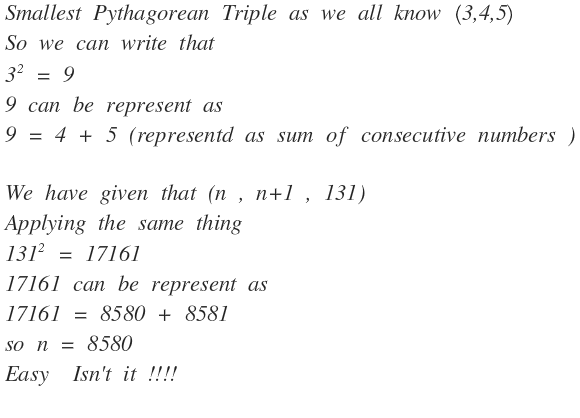Pythagorean Triples Problem
Find the value of n such that the set { n , n + 1 , 1 3 1 } form the side lengths of a right angled triangle.
The answer is 8580.
This section requires Javascript.
You are seeing this because something didn't load right. We suggest you, (a) try
refreshing the page, (b) enabling javascript if it is disabled on your browser and,
finally, (c)
loading the
non-javascript version of this page
. We're sorry about the hassle.
2 solutions
Moderator note:
Why couldn't 1 3 1 be the largest of these three numbers? That is, why can't 1 3 1 be the hypotenuse of a right triangle with sides n and n + 1 ?
You need to explain why 1 3 1 cannot be the largest side of a Pythagoras Triplet, ( n , n + 1 , 1 3 1 ) .
I'm under the assumption that n must be an integer, else there would be more than 1 solution.
Here's my working:
Suppose it is possible, then by Pythagoras Theorem, n 2 + ( n + 1 ) 2 = 1 3 1 2 , then 2 n 2 + 2 n − 1 7 1 6 0 = 0 , or n 2 + n − 8 5 8 0 = 0 . Note that the discriminant of the quadratic equation above is B 2 − 4 A C = 3 4 3 2 1 which isn't a perfect square, thus it can't have integer root. In other words, there can't have integer lengths of a right triangle of lengths n , n + 1 , 1 3 1 with 1 3 1 as its hypotenuse.
Bonus questions:
-
In the working above, why didn't I solve the quadratic equation, but instead just determine the property of its discriminant? Is it sufficient that it be a perfect square to have integer root(s)? Why or why not?
-
Prove that no right triangles with integer sides have a hypotenuse of length 1 3 1 .
IF I31 IS THE HYPOTENUSE THEN HOW TO SOLVE THE PROBLEM
Log in to reply
I assumed that 131 was the hypotenuse when attempting this. We know 131 is not the hypotenuse because it is impossible for it to be. I used a trial and error method. Here's what I did:
I knew the units digit would be 1, so I wrote down the squares of all one digit numbers.
0:
0
, 1:
1
, 2:
4
, 3:
9
, 4:1
6
, 5:2
5
, 6:3
6
, 7:4
9
, 8:6
4
, 9:8
1
Then I narrowed down the possible ones digits to either 5 and 6, 0 and 1 , or 0 and 9 because these were only only pairs that were one apart and whose squares add to a number that has a units digit of 1.
Next I began to try the numbers.
5 and 6: 85^2 + 86^2=14621, 95^2 + 96^2=18241
0 and 1: 90^2 + 91^2=16381, 100^2 + 101^2=20201
0 and 9: 80^2 + 89^2= 14321, 90^2 + 99^2=17901
I'm sorry that the formatting of the exponents did not show up correctly
Log in to reply
According to wikipedia: http://en.wikipedia.org/wiki/Pythagorean_triple
In the Pythagorean triple (x, y, z) x^2 + y^2 = z^2 i.e., x < z and y < z.
So, I think the question is not written accurately.
You can say that:
Assume that n, n+1 and 131 are three integers in a Pythagorean triple. What is the value of n?
Best regards,

According to the Pythagorean Theorem,
{ 131 }^{ 2 }+{ n }^{ 2 }={ (n+1) }^{ 2 }.
Therefore the difference between { n }^{ 2 } and { (n+1) }^{ 2 } is 17161
The formula for the difference between squares is { (n+1) }^{ 2 }={ n }^{ 2 }+(2n+1) where n is any positive integer.
Since the difference of squares is 17161, it is known that
17161=2n+1, therefore
17160=2n, therefore
8580=n.
Verifying { 131 }^{ 2 }+{ 8580 }^{ 2 }={ 8581 }^{ 2 }, the solution is proven to be correct